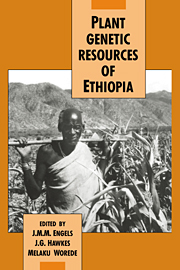Book contents
- Frontmatter
- Contents
- Contributors
- List of acronyms
- Preface
- Part I General introduction
- Part II The Ethiopian centre of diversity
- 2 The Ethiopian gene centre and its genetic diversity
- 3 Crops with wild relatives found in Ethiopia
- 4 Diversity of the Ethiopian flora
- 5 Forest genetic resources of Ethiopia
- 6 Plants as a primary source of drugs in the traditional health practices of Ethiopia
- 7 Traditional aromatic and perfume plants in central Ethiopia (a botanical and ethno-historical survey)
- 8 Spice germplasm in Ethiopia
- 9 A diversity study in Ethiopian barley
- 10 Sorghum history in relation to Ethiopia
- 11 Prehistoric Ethiopia and India: contacts through sorghum and millet genetic resources
- 12 Konso agriculture and its plant genetic resources
- Part III Germplasm collection and conservation in Ethiopia
- Part IV Evaluation and utilization of Ethiopian genetic resources
- Index
5 - Forest genetic resources of Ethiopia
Published online by Cambridge University Press: 30 October 2009
- Frontmatter
- Contents
- Contributors
- List of acronyms
- Preface
- Part I General introduction
- Part II The Ethiopian centre of diversity
- 2 The Ethiopian gene centre and its genetic diversity
- 3 Crops with wild relatives found in Ethiopia
- 4 Diversity of the Ethiopian flora
- 5 Forest genetic resources of Ethiopia
- 6 Plants as a primary source of drugs in the traditional health practices of Ethiopia
- 7 Traditional aromatic and perfume plants in central Ethiopia (a botanical and ethno-historical survey)
- 8 Spice germplasm in Ethiopia
- 9 A diversity study in Ethiopian barley
- 10 Sorghum history in relation to Ethiopia
- 11 Prehistoric Ethiopia and India: contacts through sorghum and millet genetic resources
- 12 Konso agriculture and its plant genetic resources
- Part III Germplasm collection and conservation in Ethiopia
- Part IV Evaluation and utilization of Ethiopian genetic resources
- Index
Summary
Introduction
The Ethiopian Government attaches a high priority to plantation forestry. Through institutions like the State Forests Conservation and Development Department, the Soil Conservation and Community Forestry Development Department and the revolutionary mass organizations, more than 40 000 ha of degraded lands annually are put under some kind of forest-like vegetation cover, partly as pure stands, partly in combination with other land uses such as agriculture or grazing.
This is an effort that requires the introduction of suitable trees, growing from seeds of known origin, if the forests (or agroforests) are to fulfil their objectives: erosion control and production of fodder, fuelwood, construction wood and timber. Tree species suitable for plantation forestry should have a maximum adaptability to a wide spectrum of prevailing (and sometimes rapidly changing) environmental conditions. In order to meet this requirement, the forester must be able to select from natural or planted tree populations, which must have a certain degree of genetic diversity.
Unfortunately, the Ethiopian natural tree populations have been, and still are, subject to indiscriminate destruction. Shifting cultivation and traditional grazing have been practised for centuries in Ethiopia. This, and the relentless cutting for fuel and building needs by a dense and rapidly growing population, have led to an almost complete deforestation of the Ethiopian highlands today.
The remaining forests are very unequally distributed.
- Type
- Chapter
- Information
- Plant Genetic Resources of Ethiopia , pp. 82 - 100Publisher: Cambridge University PressPrint publication year: 1991
- 5
- Cited by



